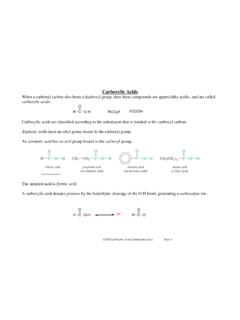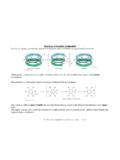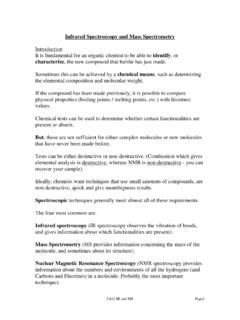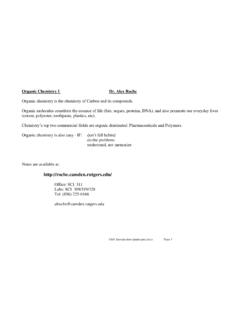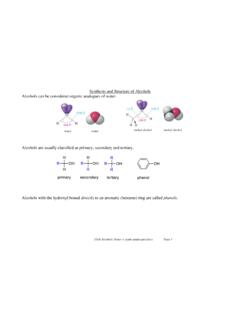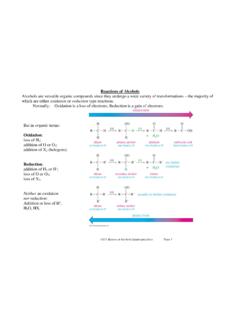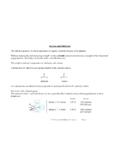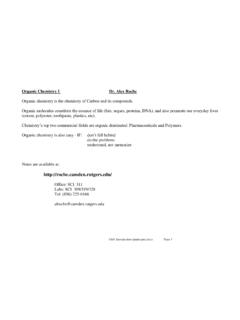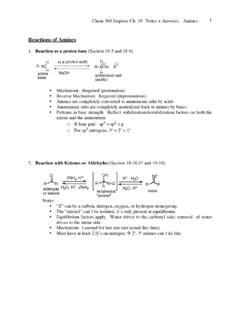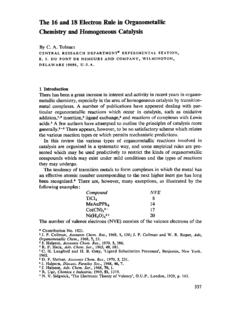Transcription of Reactions of Alkenes - Rutgers University
1 Reactions of Alkenes Since bonds are stronger than bonds, double bonds tend to react to convert the double bond into bonds This is an addition reaction. (Other types of reaction have been substitution and elimination). Addition Reactions are typically exothermic. Electrophilic Addition The bond is localized above and below the C-C bond. The electrons are relatively far away from the nuclei and are therefore loosely bound. An electrophile will attract those electrons, and can pull them away to form a new bond. This leaves one carbon with only 3 bonds and a +ve charge (carbocation). The double bond acts as a nucleophile (attacks the electrophile). Ch08 Reacns of Alkenes (landscape) Page 1. In most cases, the cation produced will react with another nucleophile to produce the final overall electrophilic addition product. Electrophilic addition is probably the most common reaction of Alkenes . Consider the electrophilic addition of H-Br to but-2-ene: The alkene abstracts a proton from the HBr, and a carbocation and bromide ion are generated.
2 The bromide ion quickly attacks the cationic center and yields the final product. In the final product, H-Br has been added across the double bond. Ch08 Reacns of Alkenes (landscape) Page 2. Orientation of Addition Consider the addition of H-Br to 2-methylbut-2-ene: There are two possible products arising from the two different ways of adding H-Br across the double bond. But only one is observed. The observed product is the one resulting from the more stable carbocation intermediate. Tertiary carbocations are more stable than secondary. Ch08 Reacns of Alkenes (landscape) Page 3. The protonation occurs at the least highly substituted end so that the cation produced is at the most highly substituted end (and therefore more stable). Markovnikov's Rule: The addition of a proton acid to the double bond of an alkene results in a product with the acid hydrogen bound to the carbon atom that already has the greater number of hydrogens attached.
3 (More generally: In an electrophilic addition to an alkene, the electrophile adds in such a way that it generates the most stable intermediate). Reactions that give such products are said to have Markovnikov orientation, and are Markovnikov products. The electrophilic addition of HBr is said to be regiospecific, since it only gives one orientation of addition. (HCl and HI perform analogous electrophilic addition Reactions ). Ch08 Reacns of Alkenes (landscape) Page 4. Free Radical addition to Alkenes It is possible to obtain anti-Markovnikov products when HBr is added to Alkenes in the presence of free radical initiators. The free radical initiators change the mechanism of addition from electrophilic addition to free radical addition. This change of mechanism gives rise to the opposite regiochemistry. Initiation: The oxygen-oxygen bond is weak, and is easily homolytically cleaved to generate two alkoxy radicals, which in turn abstract hydrogen to generate bromine radicals.
4 Ch08 Reacns of Alkenes (landscape) Page 5. Propagation: The bromine radical is electron deficient and electrophilic. The radical adds to the double bond, generating a carbon centered radical. This radical then abstracts hydrogen from a molecule of H-Br, giving the product, and another bromine radical. (Chain process). The orientation of this reaction is anti Markovnikov. The reversal of regiochemistry through the use of peroxides is called the peroxide effect. To explain the different regiochemistry, we must look at the intermediates: Ch08 Reacns of Alkenes (landscape) Page 6. The electrophile adds to the least substituted end just like before, but this time the electrophile is a bromine radical (not a proton). This generates an intermediate radical. Tertiary radicals are more stable than secondary radicals. The reaction goes through the most stable intermediate. (It still follows the expanded Markovnikov rules, but the orientation is anti Markovnikov).
5 (Radical additions do not proceed with HCl or HI, only HBr). Ch08 Reacns of Alkenes (landscape) Page 7. Addition of Water Alkenes can be converted to alcohols. It is the reverse reaction of the dehydration of alcohols to give Alkenes . The principle of microscopic reversibility states that a forward reaction and a reverse reaction taking place under the same conditions must follow the same reaction pathway in microscopic detail. (Logically, it seems sensible that the lowest energy 's and intermediates for the forward reaction would be the same for the reverse reaction but in the opposite order). So it is no surprise that the mechanism for hydration of Alkenes is identical to that of dehydration of alcohols, but in the reverse order of steps. Ch08 Reacns of Alkenes (landscape) Page 8. The first step is the protonation of the double bond to generate a carbocation, which in turn is attacked by water (a nucleophile). The final step is quick proton removal to generate the product.
6 The hydration of Alkenes is regiospecific. Ch08 Reacns of Alkenes (landscape) Page 9. The orientation is Markovnikov since the proton has added to the least highly substituted end, and the hydroxyl to the most highly substituted end. The regiochemistry is explained by the intermediate carbocation: The secondary carbocation is more stable than the primary carbocation. The reaction of dilute acid to hydrate Alkenes is not a fantastic practical route due to insolubility problems, and typically two other indirect approaches are used. (1) Addition of sulfuric acid followed by hydrolysis (2) Oxymercuration-demercuration Addition of Sulfuric Acid followed by Hydrolysis The alkene reacts with conc. sulfuric acid to give an alkyl hydrogen sulfate, which then in turn is hydrolyzed to give the alcohol. Ch08 Reacns of Alkenes (landscape) Page 10. The formation of the alkyl hydrogen sulfate arises from initial protonation on the double bond, and the intermediate carbocation is trapped by the bisulfate anion.
7 (Markovnikov addition). The alkyl hydrogen sulfate can be converted to an alcohol by boiling in water. This proceeds usually by SN1 substitution where water is the nucleophile and bisulfate is the leaving group. The product has the same regiochemistry as an alcohol formed by direct hydration of the same alkene. (Markovnikov orientation). Ch08 Reacns of Alkenes (landscape) Page 11. Oxymercuration-Demercuration This is another alternative for converting Alkenes to alcohols with Markovnikov orientation. This method has the advantage of not involving free carbocationic species, and thus removes the possibility of rearrangements. The reagent is called mercuric acetate, and is usually abbreviated to Hg(OAc)2. In solution it ionizes into acetate ion and a positively charged mercury species which is very electrophilic. Oxymercuration is the electrophilic attack of this species on a double bond, giving a 3 membered ring compound called a mercurinium ion.
8 Ch08 Reacns of Alkenes (landscape) Page 12. When water is present, the nucleophilic oxygen will open the mercurinium ring, and generate an organomercurial alcohol. Demercuration is the removal of the mercury containing species, which is achieved by reaction with Sodium borohydride, a powerful reducing agent, which replaces the mercury species with a hydrogen atom giving the desired alcohol. Oxymercuration-demercuration also gives Markovnikov orientation of the alcohol. The water molecule attacks the carbon with most positive charge (most electrophilic carbon). The electrophile +HgOAc remains bound to the less highly substituted carbon. Ch08 Reacns of Alkenes (landscape) Page 13. The stereochemistry of the product is also important: the new H and OH groups are on the opposite sides of what was the double bond - this is called anti addition. (Addition to the same side of a double bond is called syn addition). This is easier to see in cyclopentene: Oxymercuration-Demercuration gives better chemical yields than the other 2 methods, uses less harsh conditions and does not allow the possibility of carbocation rearrangements.
9 Ch08 Reacns of Alkenes (landscape) Page 14. Alkoxymercuration-Demercuration This is an extension of the previous reaction, where the reaction is performed in the presence of an alcohol rather than water. The alcohol opens the mercurinium ring, and the final product is an ether. Ch08 Reacns of Alkenes (landscape) Page 15. Hydroboration of Alkenes We have studied three ways of hydrating Alkenes to give Markovnikov orientated alcohols. There is also a way to obtain anti-Markovnikov oriented alcohols: hydroboration. Borane adds to Alkenes with anti-Markovnikov orientation, and these alkylboranes can then be oxidized to alcohols. Borane (BH3) itself is unstable, and exists either as a dimer or as a complex with THF. Ch08 Reacns of Alkenes (landscape) Page 16. Mechanism of Hydroboration Borane has only six valence electrons and is very electron deficient. Borane is an electrophilic molecule, and reacts with double bonds in a one step process to generate an alkylborane.
10 The boron atom adds to the least highly substituted end of the double bond. This places partial positive charge on the more highly substituted end of the double bond (which is more stable). Hydroboration also gives syn addition of the boron and hydrogen (and therefore the OH and H). This is a stereospecific reaction. Ch08 Reacns of Alkenes (landscape) Page 17. Stoichiometry of the Reaction In reality, each B-H bond can add across a double bond. The di- and tri-alkyl boranes behave just as the alkylboranes, but for simplicity they are often written as mono alkylboranes. Ch08 Reacns of Alkenes (landscape) Page 18. Catalytic Hydrogenation This is the addition of a hydrogen molecule to a compound using a (usually Pt, Pd, Ni) catalyst. When the catalyst is in a different physical state to the other reactants it is called Heterogeneous catalysis ( a solid catalyst with a liquid and a gas). In contrast a liquid catalyst in a reaction solution is an example of homogeneous catalysis (acid catalyzed alcohol dehydration).
